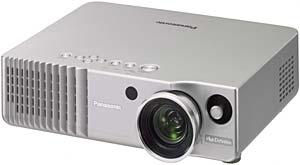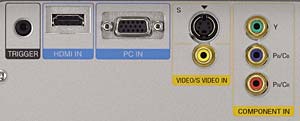Home Page |
About Me |
Home Entertainment |
Home Entertainment Blog |
Politics |
Australian Libertarian Society Blog |
Disclosures
Panasonic PT-AE700E LCD Projector
Published in Best Buys Home Theatre, Summer 2005, p.110
Last year Sound and Image magazine gave its prestigious Best Projector Under $10,000 award not to one of the famous projector companies, but to Panasonic, for the amazing feat of producing a truly high quality projector for under $4,000. Now Panasonic has replaced this projector with the PT-AE700E. It sells for the same price, but offers several improved features.
Equipment
Like its award-winning predecessor, this projector doesn't particularly look like a home theatre specialist. It could easily be a mid-sized business projector. Luggable, if not exactly super portable. It measures 335mm wide, 104mm tall and 290mm deep. The weight is a middling 3.6 kilograms.
 The guts of this projector are three LCD panels, offering a resolution of 1,280 by 720 pixels in 16:9 format. This, you will note, is the same resolution offered by some very high end projectors indeed, including those based around the 'Mustang' digital micro-mirror device.
The guts of this projector are three LCD panels, offering a resolution of 1,280 by 720 pixels in 16:9 format. This, you will note, is the same resolution offered by some very high end projectors indeed, including those based around the 'Mustang' digital micro-mirror device.
The strong point of LCD projectors is their ability to produce high output levels. Because this one is orientated to home theatre use, Panasonic has restrained it to a rating of 1,000 ANSI lumens. This is more than enough in any reasonable home theatre context. There's also a low output setting that reduces the brightness of the 130 watt UHM lamp and extends its life. Panasonic rates the lamp life at between 2,000 and 3,000 hours, depending on the various operational settings chosen.
Further control over light production is exerted by a 'Dynamic Iris'. This mechanically controls the amount of light delivered by the lamp by means of an adjustable aperture. Rather than having a couple of fixed settings, though, this adjusts rapidly across a wide range under the control of the projector's electronics, so as to extend the projector's contrast ratio.
To deliver the picture to the screen, Panasonic has bumped up the optical facilities considerably. First, the optical zoom range is massive two times. Most projectors offer between 1.2:1 and 1.35:1; 2:1 is virtually unheard of. What that means is that for a 100 inch (2.54 metre) diagonal picture, the projector can be located at a range of anywhere between 3.1 and 6.2 metres.
In addition, Panasonic has fitted this projector with a lens shift facility. This allows the throw direction of the picture to be changed by a considerable degree. Its vertical position can be adjusted up and down by the full screen height, and horizontally by around two thirds of the screen width. This allows some placement flexibility without picture distortion, avoiding the need to make keystone adjustments, which inherently reduce picture resolution. Of course, the projector has a vertical keystone adjustment anyway, even though it would be hard to think of circumstances in which it would be required.
Instead of two separate controls for the lens shift (one for vertical, one for horizontal), the projector uses a joystick on the front. This was just a little stiff on the review unit, making very fine adjustment of the picture position somewhat gruelling. This, though, will generally be a once-only adjustment. Usefully, you can lock the adjustment into place once it has been made.
 The projector has what can only be described as a full set of inputs. Naturally there are one each for composite video, S-Video, component video and VGA-style analogue computer signals. But there's also a SCART input for those with Euro-DVD players, or standard definition digital TV receivers, and a HDMI input, replacing the DVI input on the previous model.
The projector has what can only be described as a full set of inputs. Naturally there are one each for composite video, S-Video, component video and VGA-style analogue computer signals. But there's also a SCART input for those with Euro-DVD players, or standard definition digital TV receivers, and a HDMI input, replacing the DVI input on the previous model.
HDMI stands for High-Definition Multimedia Interface, a new digital connection standard that supports both audio and video. Of course, only the video signal is actually used by the projector. With an appropriately equipped DVD player or high definition digital TV receiver, the picture can be delivered digitally with no analogue degradation. DVI and HDMI are compatible by use of a plug adaptor. The projector supports the High-bandwidth Digital Content Protection (HDCP) encryption used by DVD players.
The projector also has a trigger output for integration with powered screens. The remote control has backlit keys, direct control of the picture aspect ratio and dedicated keys to select from the various inputs.
Performance
Overall, the picture performance of this unit was quite extraordinary in view of the price. Indeed, for a projector costing twice as much I would consider it a rather fine performance.
I made heavy use of the HDMI input for DVD watching (thanks to having at the time a Krell DVD player with HDMI output). Whether the picture was delivered at 576p, 720p or 1080i, the result was markedly better than any of the analogue delivery forms. In particular, the horizontal resolution of the picture increased noticably on test patterns. On regular movie viewing, the improvement was less obvious, but it still produced a subtlely cleaner and sharper result.
With the 720p and 1080i input signals, though, whether input via HDMI or the component video inputs, the aspect ratio of the unit was fixed in the widescreen mode, making it unsuitable for viewing 4:3 material. It is best, in those cases, to leave the unit switched to 576i or 576p output.
For regular signals, this projector is the only one I have ever seen that actually detects the aspect ratio and adjusts itself accordingly. While many regular TVs will do this for composite and S-Video signals, this projector also does it for component video inputs. This is a great user convenience.
Panasonic has incorporated into this projector something it calls 'Smooth Screen technology' which, it says, eliminates the 'screen door effect'. It doesn't give any details on how this works, nevertheless it clearly does. Like its predecessor, this projector managed to produce a smooth image in which there was no screen door effect evident at all at any reasonable viewing range. In this regard, the performance was at DLP--or better--levels.
But with the review projector, some element of the processing seemed to produce what looked like visible scan lines. You know, the kind of thing you see when you are too close to a CRT-based rear projection TV. What was going on here I simply couldn't work out. These appeared even with HDMI input of a 720p signal, for which there should have been no scan lines at all, so I suspect some form of aliasing. This affected primarily smooth, lighter toned parts of the pictures. Such as faces.
Fortunately after an hour or more of operation this 'scan line effect' gradually faded into imperceptibility. But one should not need to run a projector for an hour to achieve peak performance.
I had the opportunity to see another projector in operation and this issue didn't arise, so it's likely that this was limited to the review unit.
On most other aspects of performance, this projector was excellent. Panasonic claims a contrast ratio unheard-of for LCD projectors: 2,000:1. Yet I couldn't find possible to disagree with this claim. The black levels were indeed very similar to DLP-like and the colour richness fine: strong, clean, and with seemingly accurate gradients. If you don't like the default settings, there are plenty of adjustments that you can make, along with three user memory locations to hold them, allowing them to be easily recalled for different sources.
One limitation was that the de-interlacing of video-sourced material from a digital set top box, connected via S-Video, was no more than adequate, with visible combing appearing from time to time. As is often the case for Japanese sourced display products, it seemed more comfortable correcting the harder problems presented by the NTSC TV system (something similar to this is used in Japan) than those caused by PAL.
I should mention, finally, that the construction of the projector was good. The fan was very quiet, amongst the quietest of any projector I have reviewed, and there was almost no leakage of light from the case--just a very slight glow from around the rear cooling vent.
Conclusion
Panasonic has taken what was a projector that offered superb value for money, and while retaining the same price, bumped it up in several areas of both performance and features. Is it perfect? No. Nor is any other projector. But for this price is it is closer to perfection than we have any right to expect.
PRICE: $3,899
WARRANTY: Two years
CONTACT: Panasonic Australia, 132 600, www.panasonic.com.au
SMILIES:
- Excellent value for money
- Installation flexibility
- HDMI input
FROWNIES:
- Some visible interlace combing on PAL input signals
- 4:3 mode cannot be selected for high definition signals
© 2004 - Stephen Dawson
 The guts of this projector are three LCD panels, offering a resolution of 1,280 by 720 pixels in 16:9 format. This, you will note, is the same resolution offered by some very high end projectors indeed, including those based around the 'Mustang' digital micro-mirror device.
The guts of this projector are three LCD panels, offering a resolution of 1,280 by 720 pixels in 16:9 format. This, you will note, is the same resolution offered by some very high end projectors indeed, including those based around the 'Mustang' digital micro-mirror device.
 The projector has what can only be described as a full set of inputs. Naturally there are one each for composite video, S-Video, component video and VGA-style analogue computer signals. But there's also a SCART input for those with Euro-DVD players, or standard definition digital TV receivers, and a HDMI input, replacing the DVI input on the previous model.
The projector has what can only be described as a full set of inputs. Naturally there are one each for composite video, S-Video, component video and VGA-style analogue computer signals. But there's also a SCART input for those with Euro-DVD players, or standard definition digital TV receivers, and a HDMI input, replacing the DVI input on the previous model.